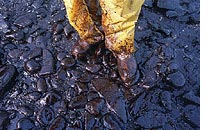
Image: AP Photo
In May 1989, the Potter brothers — Mike, Roger, and Paul — joined 11,000 men and women in the massive effort to clean up 10 million gallons of crude oil spilled when the Exxon Valdez ran aground in Alaska’s Prince William Sound. They worked the shoreline for 12 hours a day, 14 days at a stretch, picking up dead wildlife, scrubbing rocks, skimming oil off the water, and using high-pressure sprayers to treat oil-coated beaches with solvents. At night, they were ferried to barges and Navy vessels anchored offshore, where they would remove their oil-covered gear, shower, and grab some sleep before heading back to the beaches the next morning. “Out there,” Mike Potter recalls, “it was kind of like family.”
Almost from the start, however, workers employed by Exxon contractors complained of respiratory problems and ßu-like symptoms, which became known as the “Valdez Crud.” “Everybody was coming down with something,” says Potter. “We’d be given cough medicine. We figured it wasn’t a cold, but something to do with the oil.”
State and federal officials were also concerned. Crude oil contains benzene and other hazardous chemicals that can cause cancer, and the solvents used to remove oil from rocks and beaches included a compound called Inipol, which is known to cause rashes, respiratory ailments, and damage to the central nervous system, kidneys, and liver. Over the course of that summer, workers made more than 6,700 visits to Exxon-run clinics, seeking treatment for upper-respiratory infections. By the end of the year, state records show, more than 1,800 cleanup-crew members had filed for workers’ compensation, 264 of whom claimed respiratory ailments.
Federal investigators from the National Institute of Occupational Safety and Health visited Prince William Sound three times in 1989 to evaluate health hazards of the cleanup. “Attempts to survey occupational injuries and illnesses in a systematic way were unsuccessful,” NIOSH reported. Exxon refused to give investigators access to its medical records, and workers were too scattered to conduct extensive interviews. Although the cleanup continued for another two summers, the investigation into the cause of the ailments went no further.
For many workers, the health problems have worsened over the years. Today, as cleanup crews in Spain continue to scour beaches blackened with oil from the tanker Prestige that sank last November, environmental health activists in Alaska are working to track down and document the health of those who took part in the Exxon cleanup. “This is a mass chemical poisoning that Exxon has pushed under the table,” says Riki Ott, a marine toxicologist with the Alaska Forum for Environmental Responsibility, a nonprofit based in Valdez.
ExxonMobil says it complied with all federal and state health and environmental requirements during the cleanup, which cost the company $2.2 billion. “The workers were all protected in the event they may have been exposed to materials that they may have had some sensitivity, some reaction, to,” says spokesman Tom Cirigliano.
Over the years, however, the company has done what it can to deter any public scrutiny, citing employee privacy. Because workers’ ailments were diagnosed as simple colds, Exxon was not required to report them to federal or state authorities. The company offered confidential settlements to seven workers who filed lawsuits claiming health problems, and insisted that all documents remain sealed in the one case that came close to trial.
George Kapolchok, an Anchorage attorney who represented two workers who received settlements, says Exxon’s legal team tried to bury the lawsuits by inundating him with motions and document requests. “It was a procedural siege,” recalls Kapolchok. As a result of its insistence on secrecy, Exxon has succeeded in concealing even the most basic information about the cleanup workers.
Those who treat workers exposed to petroleum say crude oil and the solvents used in the Valdez cleanup can cause a host of long-term ailments, including brain damage, heart trouble, memory loss, chronic fatigue, and hypersensitivity to chemicals. “We knew immediately when the cleanup began that people would have problems,” says Dr. William Rea of the Environmental Health Center in Dallas, who has studied the effects of petroleum poisoning among refinery workers. After the cleanup, Rea treated six Valdez workers. “They didn’t get protected properly,” he says. “When I hear Exxon say there are no health effects, I say that’s baloney.”
More than 12 years after the cleanup, some workers are still grappling with debilitating ailments that they suspect are linked to the chemicals they handled. Leonard Lamb, who lives in Anchorage, spent the summer of 1990 with a container of Inipol strapped to his back as he scrambled over rocky beaches spraying oil patches. “That stuff would eat the seals on the backpacks,” he says. “Essentially, you’d be spraying and it would be running down your back and neck. You’d be coated with it.” Lamb and his colleagues asked about the chemical. “We were told there was absolutely nothing to worry about,” he recalls. “I took their word for it.”
Two years later, Lamb began feeling sick. For the past decade he has suffered from chronic skin rashes, thyroid problems, and immune disorders. When he heard of other cleanup workers who had fallen ill, he began to think his ailments might be connected to the Valdez spill. “It makes sense now that I think about it,” Lamb says.
Mike Potter noticed a change in his health in 1990, a year after he worked on the spill. Potter, who lives in Haines, Alaska, had trouble remembering simple things and was constantly tired, conditions that have worsened over the years. His brother Roger developed brown blotches on his legs. “It’s like I have a tan,” he explains.
During the cleanup, their brother Paul was hospitalized after he was knocked unconscious by the fumes from a plastic bag of oil-soaked wildlife and debris. “It was like he had been gassed,” recalls Mike. Afterward, Paul complained of memory loss, chronic fatigue, and a heightened sensitivity to chemicals. He was gathering the names of other ailing workers and contemplating a lawsuit when he died of a heart attack at the age of 44.
Given Exxon’s refusal to cooperate, activists concede that locating former cleanup workers will be time-consuming — and that proving the cause of their illnesses after so many years will be extremely difficult. Pamela Miller, who is helping to track down former Exxon workers as director of a nonprofit group called Alaska Community Action on Toxics, hopes that the health effects of the disaster will receive renewed attention in the wake of the Prestige disaster last fall. Cleanup supervisors in Spain were recently instructed to turn away volunteers because of the health dangers posed by the oil.
“The oil companies know the dangers of this stuff,” says Miller, as she watches reports of cleanup workers gathering up toffee-thick oil with shovels. “Nobody provided the workers with any protection. It’s going to happen all over again.”

















